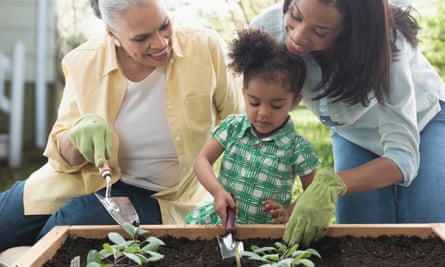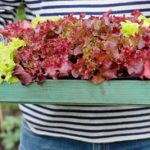There are as many tools filling garden centre aisles as there are jobs to do on your plot. But just as in the kitchen you could ditch a dozen specialist slicing-and-dicing gadgets and replace them with one decent knife, so, too, in the garden you can get by with a minimal amount of versatile gear. And while it is generally sensible to buy the best tools that you can afford, preparing to grow your own need not be costly.
Planting
The first thing you will need is something to sow seeds in. For years, the industry standard has been lightweight black plastic trays but these are flimsy and usually unrecyclable.
A fresh approach: cut food bills by growing your own fruit and vegRead more
Other options such as Fibre Starter Cells (£5.99 for three trays) are biodegradable but tend to dry out quicker and so demand a more attentive watering regime. They also are not likely to last beyond one growing season. A better option might be Natural Rubber Reusable seed trays (from £15.99), which combine decent sustainability credentials with a multiyear lifespan.
If a childhood spent watching Blue Peter encouraged you to hoard spent loo and kitchen roll tubes, these can be cut into two-inch sections and used as individual seed modules.
 View image in fullscreenSweet peas sown in recycled toilet roll inners. Photograph: Deborah Vernon/Alamy
View image in fullscreenSweet peas sown in recycled toilet roll inners. Photograph: Deborah Vernon/Alamy
As for making holes in your compost in which to plant your seeds, the market is awash with diversely designed dibbers. If you are going to buy one, opt for one with measurements marked along its length, but an old pencil or chopstick is equally effective.
No space for a greenhouse? Join the club. But there are more modest options available for giving seeds a good start. Sankey manufactures a two-tray heated propagator (from £27.50), which combines ease of use with affordability. But by mid-May, most seeds will sprout just fine if placed on a warm, sunny windowsill.
Once they are ready they can go outside to their final growing place, be that the ground, a raised bed, or a container – which can be anything from a yoghurt pot to an old boot to a stack of tyres, as long as you ensure adequate drainage.
Digging
 View image in fullscreenWeed-pulling and flower-planting made easy. Photograph: Blend Images/Alamy
View image in fullscreenWeed-pulling and flower-planting made easy. Photograph: Blend Images/Alamy
For the container gardener or novice grower, most hole-making and weed-pulling jobs can be completed with a hand trowel or hand fork or both. Spear & Jackson is a reliable entry-level brand, and you can pick up a pair of basic tools for about £15.
I am a convert to the all-in-one Japanese master blade: the hori hori (from about £20). It is sharp, curved and robust enough for almost any small-scale digging or weeding job.
Cutting
When growing your own produce, all you need is a decent pair of secateurs. You can pick up a pair for pennies from your local pound shop or garden centre – but don’t. You really do get what you pay for.
My secateurs of choice are the Okatsune No 103s. These are made of Japanese steel and built to last, with red-and-white handles that help you spot them in an overgrown border. You can find them on sale fairly widely for about £45.
I once spent some time on a vineyard on the outskirts of London. The head grower, who at certain times of year has to prune hundreds of seasoned vines every day, swore by his slightly more expensive Felco 12 secateurs (£55.99) with a revolving handle designed to reduce wrist strain.
Even the best will eventually lose their lustre – to prolong their shelf life, keep them clean, sharp and well oiled.
If the only cutting you are doing in your garden, patio or balcony is harvesting your fruit and veg, then a sharp knife or pair of kitchen scissors will just as easily do the trick.
Feeding and watering
 View image in fullscreenMost crops will benefit from a regular feed. Photograph: rbkomar/Getty Images
View image in fullscreenMost crops will benefit from a regular feed. Photograph: rbkomar/Getty Images
To avoid roughing up your seeds and seedlings, it is best to avoid a mains-pressure garden hose and instead opt for a watering can – ideally one with a fine nozzle to avoid drenching tender plants. I try to limit my use of plastic in the garden but be warned that cheap steel cans have a tendency to corrode.
Once they get going, most crops will benefit from a regular feed, and there are lots of pre-packed and pre-bottled options out there, organic and not. But there is a more economical and enjoyable approach to plant nutrition.
A worm farm (or wormery or vermicomposter) is basically a small, worm-run compost bin. Food waste and paper scraps go in, the worms do their thing, and the end product is a double whammy offering of compost and nutrient-rich liquid plant feed (AKA worm wee). Worm farms are odour-free, rodent-proof and can be kept indoors or out. I have a French-made WormBox that I keep in a shady corner by the shed.
Footwear
I do most of my gardening in a pair of old open-toed pool slides, which means any outing to water my plants is usually followed by a change out of soggy socks. Garden clogs will not win you any style plaudits (knee pads also fall into this ugly-yet-useful category) but they will at least keep your feet dry. Aigle and Birkenstock have slip-on, closed-toe options.
-
Daniel Masoliver is a freelance writer and author of the alternative gardening newsletter The Earthworm


